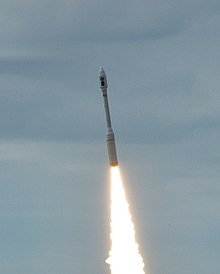
Back Тавър (ракета) Bulgarian Minotaur-C Czech Minotaur-C German Taurus (cohete) Spanish تاوروس Persian Taurus (raketti) Finnish Minotaur-C French Taurus (foguete) Galician טאורוס (משגר לוויינים) HE Minotaur-C Hungarian
 Minotaur-C launching its return-to-flight in 2017 | |
| Function | Orbital launch vehicle |
|---|---|
| Manufacturer | Orbital Sciences, Orbital ATK, Northrop Grumman |
| Country of origin | United States |
| Cost per launch | US$40−50 million [1] |
| Size | |
| Height | 27.9 m (92 ft)[citation needed] |
| Diameter | 2.35 m (7 ft 9 in)[citation needed] |
| Mass | 73,000 kg (161,000 lb)[citation needed] |
| Stages | 4 |
| Capacity | |
| Payload to LEO | |
| Mass | 1,458 kg (3,214 lb) |
| Payload to SSO | |
| Mass | 1,054 kg (2,324 lb) |
| Launch history | |
| Status | Active |
| Launch sites | Vandenberg, SLC-576E |
| Total launches | 10 |
| Success(es) | 7 |
| Failure(s) | 3 |
| First flight | 13 March 1994, 22:32 UTC USA 101 / USA 102 |
| Last flight | 31 October 2017, 21:37 UTC |
| First stage – Castor 120 | |
| Powered by | 1 Solid |
| Maximum thrust | 1,606.6 kN (361,200 lbf) |
| Specific impulse | 286 s (2.80 km/s) |
| Burn time | 83 seconds |
| Propellant | Solid |
| Second stage – Taurus-1 | |
| Powered by | 1 Solid |
| Maximum thrust | 484.9 kN (109,000 lbf) |
| Specific impulse | 285 s (2.79 km/s) |
| Burn time | 73 seconds |
| Propellant | Solid |
| Third stage – Pegasus-2 | |
| Powered by | 1 Solid |
| Maximum thrust | 118.2 kN (26,600 lbf) |
| Specific impulse | 292 s (2.86 km/s) |
| Burn time | 73 seconds |
| Propellant | Solid |
| Fourth stage – Pegasus-3 | |
| Powered by | 1 Solid |
| Maximum thrust | 34.57 kN (7,770 lbf) |
| Specific impulse | 293 s (2.87 km/s) |
| Burn time | 65 seconds |
| Propellant | Solid |
Minotaur-C (Minotaur Commercial), formerly known as Taurus[1] or Taurus XL, is a four stage solid fueled launch vehicle built in the United States by Orbital Sciences (now Northrop Grumman) and launched from SLC-576E at California's Vandenberg Air Force Base. It is based on the air-launched Pegasus rocket from the same manufacturer, utilizing a "zeroth stage" in place of an airplane. The Minotaur-C is able to carry a maximum payload of around 1458 kg into a low Earth orbit (LEO).[2]
First launched in 1994, it has successfully completed seven out of a total of ten military and commercial missions.[3] Three of four launches between 2001 and 2011 ended in failure, including the 24 February 2009 launch of the Orbiting Carbon Observatory mission[4] and the 4 March 2011 launch of the Glory mission,[5] which resulted in losses totalling US$700 million for NASA (excluding the cost of the rockets themselves).[6][7] The Taurus launch vehicle was subsequently rebranded in 2014 as Minotaur-C,[8] which incorporates new avionics based on those used by the Minotaur family of rockets.[1][3] After a six years pause, the rocket successfully returned to flight in 2017 as Minotaur-C.
- ^ a b Clark, Stephen (24 February 2014). "Taurus rocket on the market with new name, upgrades". Spaceflight Now. Retrieved 26 May 2014.
- ^ "Minotaur-C_Factsheet.pdf" (PDF). northropgrumman.com.
- ^ a b Krebs, Gunter. "Taurus / Minotaur-C". Retrieved 26 May 2014.
- ^ Cite error: The named reference
newscientist_ocowas invoked but never defined (see the help page). - ^ "Glory". NASA.
 This article incorporates text from this source, which is in the public domain.
This article incorporates text from this source, which is in the public domain.
- ^ "NASA launch mishap: Satellite crashes into ocean". CBS. 4 March 2011.
- ^ "NASA science satellite lost in Taurus launch failure". Spaceflight Now. 4 March 2011.
- ^ Clark, Stephen. "Taurus rocket on the market with new name, upgrades". Spaceflight Now. Retrieved 31 October 2017.
© MMXXIII Rich X Search. We shall prevail. All rights reserved. Rich X Search